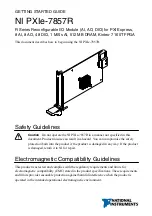
Publication 1734-UM015A-EN-E - November 2009
Introduction
11
Stand Alone DeviceLogix
If DeviceLogix is enabled (programmed), then the module becomes the owner
of its outputs. The DeviceLogix program reads inputs and controls the
onboard outputs.
•
The produced assembly may be shared with a controller if a connection
exists.
•
As the owner of its local outputs, the module may run without an
external controller.
An external controller, which is the owner of the connection to the module,
can influence the module’s logic via a consume assembly – both digital and
analog data. Configuration of the module is performed via RSNetWorx for
DeviceNet. When used on ControlNet or EtherNet/IP, the tool bridges
through the adapter to directly communicate with the DeviceLogix module on
the POINT I/O backplane.
Peer Enabled POINT I/O
The POINT I/O DeviceLogix module can “listen in” on data connections to
other POINT I/O modules on the backplane. This data can be used in the
DeviceLogix program to control the outputs. It can consume data from 8
different peers. The data from each peer can be up to 24 bytes long. The data
can be digital, analog (16-bit), or a mixture. The module supports the “Auto
Produce” parameter to produce I/O data automatically without the need for a
master. It will also produce and consume network data. Configuration of peer
data is performed via RSNetWorx.
Chapter 6, Configuring POINT I/O and ArmorPOINT I/O DeviceLogix
Summary of Contents for 1734-8CFGDLX
Page 6: ...Publication 1734 UM015A EN E November 2009 4 Table of Contents Notes ...
Page 10: ...Publication 1734 UM015A EN E November 2009 8 Preface Notes ...
Page 16: ...Publication 1734 UM015A EN E November 2009 14 Introduction Notes ...
Page 109: ...Publication 1734 UM015A EN E November 2009 Peer Data Maps 107 Notes Allen Bradley HMIs ...
Page 110: ...Publication 1734 UM015A EN E November 2009 108 Peer Data Maps Notes ...
Page 111: ...Allen Bradley HMIs ...














































